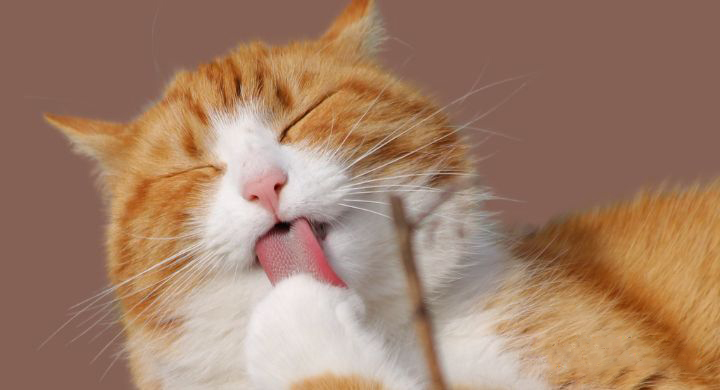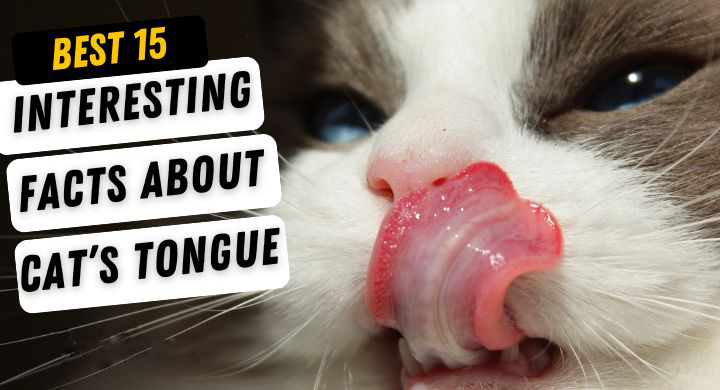We all know that a cat’s ears, eyes, and tail are important communication tools when understanding what our pets may be feeling. But did you know that a cat’s tongue can also play a role in communication?
A cat’s tongue covers many important functions and we often take this muscled organ for granted. cats’ tongues aren’t there just for decoration.
Cats’ tongues, like human tongues, are amazing masterpieces. Did you know that the tongue is the only muscle that is capable of working independently of the skeleton? That means your cat can wiggle its tongue around without using any other body part to help it move!
Here are 15 surprising facts about cat tongues, from their incredible ability to detect taste to how they can actually use them as a weapon against us!
Top 15 Interesting Facts About Cat’s Tongue That Will Surprise You

Fact #1. Cats’ Tongues Are Rough
Cats have a rough tongue because they use it to groom themselves by removing loose fur from their bodies.
The roughness also helps them clean their fur while they’re grooming themselves, which is why it’s so important that your cat has access to water at all times if they don’t have someone else at home who can help them groom themselves on a regular basis.
Fact #2. Cat’s Tongue Is Pink And Slimy
The color of your cat’s tongue is directly related to its diet—specifically, how much moisture they get from its food sources every day (think: wet food vs dry kibble).
If they eat mostly wet food, then their tongue will be pinker than if they eat mostly dry kibble because it contains more moisture than dry
Fact #3. Cat’s Tongue Length
A cat’s tongue is about 10-12 inches long. When it is fully extended, it can reach up to three times the length of its body. The average adult cat has a tongue that is about half an inch wide with over 100 rows of tiny barbs on each side of it.
Some cats have pink or red tongues while others have black or white ones depending on their breed or genetics (source).
Fact #4. Cat’s Tongue Shape
The shape of a cat’s tongue makes it easy for them to clean themselves while they’re grooming themselves by licking off dirt and debris from their fur as well as removing dead skin cells from their body (source).
Fact #5. Cat’s Tongue Functions
Cats use their tongues for many things other than just eating food or drinking water; they also use them when cleaning themselves after eating something messy.
- Cats use their tongues as a broom to clean themselves after eating something messy like a mouse or bird.
- Cats use their tongues to clean dirt and debris from between their toes.
- Cats use their tongues to clean food off of their teeth when they eat.
- Cats use their tongues as a sort of “taste sensor” when they drink water, which helps them determine whether or not it’s safe to drink.
Fact #6. Cats Can Use Their Tongue to Taste and Smell.
Taste buds are located on the sides of the cat’s tongue, allowing them to taste the food before swallowing it. They also have a vomeronasal organ (VNO), which allows them to detect pheromones in urine, feces, and other scents.
Fact #7. The Spines Of A Cat’s Tongue Are Made Of Keratin
The spines of a cat’s tongue are made of keratin, the same stuff that makes up your fingernails and hair. The spines are called papillae, and they are located along the sides of the tongue. These little spikes can be anywhere from one to three millimeters long.
Fact #8. The Cat’s Tongue Has a Larger Number of Taste Buds than The Average Dog or Human Tongue.
Cats do not have taste buds on their palates or upper lips, so they tend to lick their chops after eating or drinking. This is not because they enjoy the taste but because they are trying to moisten their mouth so that they can swallow.
Fact #9. Cats Also Use Their Tongues to Groom Other Animals
Cats not only groom themselves, but they also use their tongues to groom other animals! A cat’s tongue is a very useful tool that helps it clean and grooms itself. It also helps them clean and grooms other animals.
It is believed that cats use their tongues to clean the fur of their prey. They also use their tongues to clean the fur of humans, which may explain why they are so affectionate toward us.
Fact #10. Cat’s Tongues Help Cats Clean Themselves
Cats have powerful saliva that contains both enzymes and acids that help them break down their prey after a kill. This same saliva can be used to clean themselves and keep their fur shiny by licking it away with their tongues.
If you’ve ever seen your cat lick his fur or spread saliva around on his body, this is what he was doing—and he was probably enjoying himself! Cat tongues are also great at cleaning wounds because they help stop bleeding and kill bacteria that may cause infection.
Fact #11. These Tongues Help Cats Hunt For Food
Cats use their long tongues to reach into small spaces in order to get at prey like birds or mice that would be too big for them to eat whole if they were caught by accident on the ground or in an open space where they could be easily seen by predators like hawks or owls. Longer tongues mean more surface area for licking up tasty morsels from hard-to-reach places
Fact #12. The Tongue Is Covered in Barbs
The tongue is covered in tiny barbs that help the cat grip its prey and pull it into its mouth. The barbs also make it more difficult for the prey to escape once it’s inside.
- The tongue is covered in tiny barbs that help the cat grip its prey and pull it into its mouth.
- The barbs also make it more difficult for the prey to escape once it’s inside.
- This helps cats catch their food more quickly, without having to chase after it as much.
- Barb length varies from species to species but generally ranges from 1/2 inch to 3 inches long.
Fact #13. The Papillae Contain Taste Buds.
Cat’s tongue is covered with tiny, bumpy projections called papillae. These are where your cat’s taste buds are located. Cats have around 220 different types of papillae, which means that they can sense flavors more precisely than you can!
Fact #14. Cat’s Tongues Are Also Covered in Ridges and Grooves that Help Them Manipulate Food.
These ridges are very rough, with a texture similar to sandpaper. This allows cats to effectively break up food into smaller pieces for easier swallowing. The ridges also help cats lap up liquids, like water or milk.
Fact #15. Cats Have Unique Tongues Compared to Other Mammals
Cats have unique tongues compared to other mammals. Their tongue has tiny spines, called papillae, which help them clean their fur and keep it clean.
Cats’ tongues are also covered in tiny barbs, which help them lap up liquids. They can lap up water at a rate of 20 times per second, which is much faster than humans!
FAQ-Interesting Facts About Cat’s Tongue
1. Why Is Cat’s Tongue Rough?
Ans: The cat’s tongue is rough because it is covered in tiny hairs called papillae, which are used to help the cat lap up liquids. The papillae on a cat’s tongue make it more efficient at sipping up water and other liquids from shallow bowls or containers. The rough texture also helps them clean their fur as they groom themselves.
2. Why Cat Show Tongue?
Ans: Cats show their tongues because they are very expressive animals. They use their tongues to communicate with other cats and us humans. They also use their tongues to clean themselves and get rid of dead hair.
3. Is the Tongue of A Cat Clean?
Ans: Yes, the tongue of a cat is clean. It helps to keep the mouth and teeth clean by removing bacteria from food prior to swallowing. The tongue also has tiny projections called papillae that act like cleaning tools during grooming.
4. Are Cats Tongues Wet?
Ans: Yes, cats’ tongues are wet. They have to be! Cats eat meat, so they need their tongues to be moist so that they can lick up their prey’s juices.
5. Is Cats Saliva Poisonous?
Ans: No. Cat Saliva is not poisonous. Their saliva is not toxic for humans, but it can cause an allergic reaction if you have a cat allergy.
Conclusion
The cat’s tongue is more than meets the eye! With its rough texture, clever structure, and versatility, it’s essential for grooming, eating, and drinking. These intriguing facts reveal just how this unique organ supports a cat’s daily life and survival instincts.
Now, you can fully appreciate the remarkable role of your cat’s tongue in their health and happiness!




